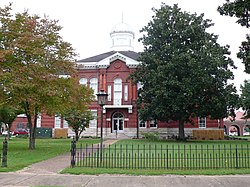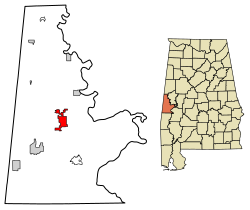Demographics
Historical population| Census | Pop. | Note | %± |
|---|
| 1870 | 500 | | — |
|---|
| 1880 | 738 | | 47.6% |
|---|
| 1890 | 850 | | 15.2% |
|---|
| 1900 | 851 | | 0.1% |
|---|
| 1910 | 877 | | 3.1% |
|---|
| 1920 | 968 | | 10.4% |
|---|
| 1930 | 1,072 | | 10.7% |
|---|
| 1940 | 1,170 | | 9.1% |
|---|
| 1950 | 1,681 | | 43.7% |
|---|
| 1960 | 1,544 | | −8.1% |
|---|
| 1970 | 2,358 | | 52.7% |
|---|
| 1980 | 3,187 | | 35.2% |
|---|
| 1990 | 3,530 | | 10.8% |
|---|
| 2000 | 3,297 | | −6.6% |
|---|
| 2010 | 3,485 | | 5.7% |
|---|
| 2020 | 3,436 | | −1.4% |
|---|
|
2020 census
As of the 2020 United States census, there were 3,436 people, 1,211 households, and 592 families residing in the city.
2000 census
As of the census [11] of 2000, there were 3,297 people, 1,368 households, and 731 families living in the city. The population density was 463.1 inhabitants per square mile (178.8/km2). There were 1,586 housing units at an average density of 222.8 per square mile (86.0/km2). The racial makeup of the city was 60.78% Black or African American, 37.82% White or Caucasian, 0.18% Asian, 0.15% Native American, 0.30% from other races, and 0.76% from two or more races. 1.43% of the population were Hispanic or Latino of any race.
Of the 1,368 households, 29.4% had children under the age of 18 living with them, 30.0% were married couples living together, 20.2% had a female householder with no husband present, and 46.5% were non-families. 35.5% of all households were made up of individuals, and 10.8% had someone living alone who was 65 years of age or older. The average household size was 2.31 and the average family size was 3.14.
In the city, the population was spread out, with 26.2% under the age of 18, 23.7% from 18 to 24, 24.2% from 25 to 44, 16.5% from 45 to 64, and 9.4% over the age of 65. The median age was 25 years. For every 100 females, there were 85.9 males. For every 100 females aged 18 and higher, there were 78.0 males.
The median income for a household in the city was $13,516, and the median income for a family was $22,500. Males had a median income of $31,838 as opposed to $20,833 for females. The per capita income for the city was $11,640. About 39.4% of families and 46.1% of the population were below the poverty line, including 53.4% of those under age 18 and 26.0% of those aged 65 years or more.
History
The area now known as Livingston was part of the traditional territory of the nation of Choctaw Indians until the Treaty of Dancing Rabbit Creek in 1830. The federal government removed most of the Choctaw to Indian Territory in present-day Oklahoma. At that time, settlers from the Carolinas, Georgia, Tennessee, and Virginia established the first European-American community about two blocks from the current Courthouse Square, near the corner of Madison and Spring Streets.
In 1833, a commission was formed to organize Sumter County. Livingston was named after a well-known statesman and jurist of the day, Edward Livingston. [4] Livingston was chosen as the county seat. Soon followed the first newspaper, The Voice of Sumter; four schools (including Livingston Female Academy, now The University of West Alabama), the courthouse, and the Bored Well.
The first courthouse was built of logs. It was replaced by a frame courthouse in 1839, which burned in 1901. The Probate Judge's office, built at the same time, survived the fire. It now houses the county commission office.
In 1931, William Faulkner traveled through Livingston, Alabama, while researching rural communities in the Deep South for his ongoing literary work. [12] During his visit, he met a local storekeeper named John “Jack” McAllister, whose eccentric mannerisms and storytelling left a lasting impression on Faulkner. [13] McAllister’s sharp wit, occasional gruffness, and hidden generosity are widely believed to have inspired the character of Gavin Stevens, the thoughtful county attorney who appears in Faulkner’s The Town (1957) and other related works set in Yoknapatawpha County. [14]
Faulkner’s brief stay in Livingston is often cited by scholars as an example of how his encounters in small Southern towns directly informed his portrayal of complex, morally ambiguous characters within a tightly-knit community. [12]
In the latter part of the nineteenth century, Livingston became widely known as a health spa because of the water from its Bored Well, one of many that made extensive settlement possible in the Black Belt. This well was bored by an old blind mule which pulled an auger around until an artesian aquifer was reached in 1857. Promoters built a Chinese-styled pagoda over the well. In 1924 the pagoda was replaced by the predecessor to the present pavilion.
During the early part of the twentieth century, Livingston continued to be known as a health resort. It was also the site of the Alabama Normal School, which developed from the Livingston Female Academy and was established to train teachers for the public school system founded during the Reconstruction era. Reflecting its expanding programs and level of curriculum, the name of the college was later changed to the State Teachers College, then to Livingston State College, Livingston University and finally to The University of West Alabama.
Livingston continued as the sleepy county seat of a mainly rural county, with a declining population. In the early 1960s, citizens made an effort to revitalize the town, building on their historic heritage and main street. The results were a near doubling in population in ten years, and corresponding increase in industry and businesses. In 1972 Livingston was named a finalist in the "All American Cities Competition", sponsored by The Saturday Evening Post.



